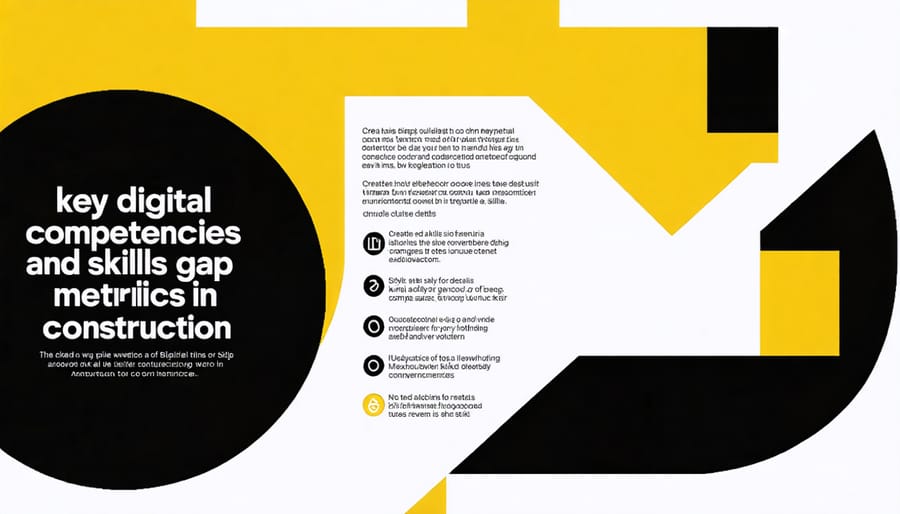Transform your construction operations for the digital age by establishing clear technology adoption benchmarks, implementing comprehensive digital skills training programs, and creating data-driven decision-making protocols. The rapid pace of digital transformation in construction demands immediate action from industry leaders to maintain competitive advantage and operational efficiency.
Today’s construction projects require seamless integration of Building Information Modeling (BIM), cloud-based project management platforms, and real-time collaboration tools. Forward-thinking organizations are achieving 20-30% productivity gains through strategic digital implementation, while those hesitating risk falling behind in an increasingly technology-driven industry.
Success in modern construction hinges on three critical elements: a digitally proficient workforce, integrated technology infrastructure, and standardized digital workflows. Construction companies must assess their current digital readiness across these dimensions and develop targeted strategies to close capability gaps, particularly in areas of data analytics, virtual design and construction (VDC), and automated project controls.
The Digital Construction Skills Crisis

Key Digital Competencies for Modern Construction
In today’s rapidly evolving construction landscape, addressing the construction skills shortage requires professionals to master essential digital competencies. Building Information Modeling (BIM) proficiency stands as a cornerstone skill, enabling teams to create, analyze, and manage digital representations of physical construction assets. Project management software expertise, including platforms like Procore and PlanGrid, has become non-negotiable for efficient project delivery.
Data analytics capabilities are crucial for interpreting project metrics, cost analysis, and performance tracking. Construction professionals must also demonstrate proficiency in mobile technologies and cloud-based collaboration tools, ensuring seamless communication across project stakeholders. Understanding digital documentation systems, including e-permits and compliance tracking, is essential for maintaining regulatory standards.
Emerging technologies like drone operation, 3D printing, and augmented reality applications represent the next frontier of digital competencies. Additionally, cybersecurity awareness has become vital as construction operations increasingly rely on connected systems and digital data exchange. These skills form the foundation of a digitally competent construction workforce, ready to leverage technology for improved project outcomes.
The Cost of Digital Unpreparedness
The financial implications of digital unpreparedness in construction projects can be severe, with industry research indicating that digitally unprepared companies face up to 20% higher project costs and experience significant schedule delays. Studies show that organizations lacking proper digital skills waste an average of 130 hours per project due to inefficient processes and communication breakdowns.
Poor digital readiness often leads to costly rework, with estimates suggesting that between 7-15% of construction costs are spent correcting errors that could have been prevented through proper digital tool utilization. Companies report that inadequate digital skills result in data silos, compromised quality control, and missed opportunities for process optimization.
Beyond immediate project impacts, organizations face long-term competitive disadvantages. Industry leaders implementing digital solutions report 15-25% higher productivity rates and secure 30% more contracts than their less digitally prepared counterparts. The cost of training and upskilling may seem significant initially, but it pales in comparison to the accumulated losses from digital inefficiency.
Furthermore, insurance providers are increasingly considering digital preparedness when assessing risk profiles, potentially affecting premium rates and coverage terms for construction companies.
Assessing Digital Construction Readiness

Technical Infrastructure Assessment
A thorough assessment of existing digital infrastructure forms the foundation of any successful digital construction transformation. This evaluation encompasses both hardware and software components currently in use across construction operations. Key areas of focus include Building Information Modeling (BIM) capabilities, cloud-based project management systems, mobile device integration, and data collection tools.
Organizations must evaluate their current digital asset inventory, including computers, mobile devices, network infrastructure, and specialized construction technology. This assessment should also examine software licenses, version compatibility, and integration capabilities between different systems. Special attention should be paid to the organization’s data storage solutions, security protocols, and backup systems.
The evaluation process should identify potential bottlenecks in digital workflows, such as outdated hardware, insufficient network bandwidth, or incompatible software systems. It’s crucial to assess whether existing tools support real-time collaboration, remote access capabilities, and data sharing across different stakeholders.
Common gaps often include inadequate mobile connectivity on construction sites, limited cloud storage capacity, or outdated visualization tools. The assessment should also consider the scalability of current systems to accommodate future growth and technological advancement.
This technical infrastructure evaluation provides valuable insights for developing a targeted digital transformation strategy, helping organizations prioritize investments in technology upgrades and identify necessary system improvements to support digital construction initiatives.
Workforce Capability Analysis
Assessing your organization’s digital readiness begins with a comprehensive evaluation of your workforce’s current digital capabilities. This systematic approach to workforce capability development involves multiple assessment methods to gauge existing skill levels and identify gaps.
Digital skills assessments typically encompass three key areas: technical proficiency, digital literacy, and adaptability to new technologies. Organizations can utilize standardized assessment tools, such as digital competency frameworks and skills matrices, to measure employee capabilities across various digital platforms and tools commonly used in construction projects.
Key measurement methods include:
– Technical skills assessments through practical demonstrations
– Online competency tests focusing on specific digital tools
– Self-assessment questionnaires
– Performance evaluations during digital tool usage
– Project-based assessments measuring digital workflow efficiency
The gathered data should be analyzed against industry benchmarks and organizational requirements to create a clear picture of current capabilities. This analysis helps identify skill gaps and training needs while providing insights for developing targeted upskilling programs.
Regular reassessment ensures continuous improvement and helps track progress in digital capability development. Organizations should maintain detailed records of assessment results to monitor trends and adjust training strategies accordingly.
Building Digital Construction Capability

Structured Training Programs
Implementing structured training programs is essential for developing digital competencies across construction organizations. These programs should follow a systematic approach that combines theoretical knowledge with practical application, ensuring employees can effectively utilize digital tools and processes in their daily work.
A well-designed digital training program typically consists of multiple tiers, starting with fundamental digital literacy and progressing to advanced technology applications. The initial phase focuses on basic digital skills, including file management, collaboration tools, and standard construction software. Intermediate levels cover Building Information Modeling (BIM), project management platforms, and digital documentation systems.
Industry leaders have found success with blended learning approaches, combining online modules with hands-on workshops. This method allows employees to learn at their own pace while ensuring practical experience with digital tools. Regular assessments and feedback mechanisms help track progress and identify areas needing additional support.
Case studies from leading construction firms show that modular training programs, which break down complex digital concepts into manageable segments, achieve higher completion rates and better knowledge retention. For example, a major UK contractor reported a 40% improvement in digital tool adoption after implementing a structured, step-by-step training approach.
To maintain effectiveness, training programs should be regularly updated to reflect new technologies and industry standards. Establishing partnerships with technology vendors and educational institutions can provide access to current training materials and expert instruction. Additionally, creating internal digital champions who can provide ongoing support and mentorship helps sustain the learning culture and ensures continuous skill development across the organization.
Technology Integration Strategies
Successful technology integration in construction requires a strategic, phased approach that minimizes disruption while maximizing adoption. Begin by conducting a thorough assessment of existing workflows and identifying processes that would benefit most from digital transformation. This evaluation should prioritize high-impact, low-resistance areas for initial implementation.
Start with pilot programs on smaller projects to test new digital tools and gather feedback. Select tech-savvy team members as “digital champions” who can support their colleagues and demonstrate the practical benefits of new technologies. These champions play a crucial role in reducing resistance and accelerating adoption across the organization.
Implement new technologies using a modular approach, introducing one tool or process at a time. This prevents overwhelming staff and allows for proper training and adjustment periods. Consider starting with mobile apps for site documentation, followed by cloud-based collaboration platforms, and gradually moving toward more complex solutions like BIM integration.
Establish clear protocols for data management and standardization across digital platforms. Create detailed documentation and training materials that are easily accessible to all team members. Regular training sessions, both formal and informal, help ensure consistent usage and understanding of new tools.
Monitor adoption rates and gather feedback continuously to identify barriers and opportunities for improvement. Use metrics to track productivity gains and ROI to demonstrate value to stakeholders. Be prepared to adjust implementation strategies based on real-world performance and team feedback.
Remember that successful technology integration is an ongoing process that requires commitment from leadership and consistent communication with all stakeholders. Regular reviews and updates ensure that digital solutions remain aligned with organizational goals and industry best practices.
Creating a Digital-First Culture
Creating a digital-first culture requires a strategic approach that transforms traditional construction practices into technology-driven operations. Success begins with leadership commitment and clear communication of the digital vision across all organizational levels.
Start by establishing a dedicated digital transformation team that includes representatives from various departments. This cross-functional approach ensures that digital initiatives address real operational needs while maintaining practical applicability. Regular training sessions, workshops, and hands-on demonstrations help team members understand and embrace new digital tools and processes.
Implement a mentorship program where digitally proficient staff can guide others through the adoption process. This peer-to-peer learning approach often proves more effective than formal training alone, as it provides continuous support and practical insights within the context of daily operations.
Create incentive structures that reward digital innovation and adoption. Recognition programs, performance metrics tied to digital proficiency, and opportunities for advancement based on technical expertise can motivate staff to embrace new technologies actively.
Establish a feedback loop system where employees can share their experiences, challenges, and suggestions regarding digital tools and processes. This collaborative approach helps identify areas for improvement and ensures that digital solutions truly serve their intended purpose.
Document and share success stories across the organization. When teams see concrete examples of how digital tools improve efficiency, reduce errors, or enhance project outcomes, they’re more likely to embrace change. Consider creating case studies of successful digital implementations and their measurable benefits.
Finally, maintain momentum through regular assessment and updates of digital initiatives. Technology evolves rapidly, and staying current requires ongoing evaluation and adaptation of digital strategies. This proactive approach ensures your organization remains competitive and continues to benefit from technological advances in the construction industry.
Achieving digital construction readiness requires a strategic and systematic approach that combines technological adoption, workforce development, and organizational change management. As we’ve explored throughout this article, successful digital transformation in construction demands careful planning and committed execution across multiple fronts.
To ensure your organization becomes truly digital construction ready, focus on these essential action items. First, conduct a comprehensive digital maturity assessment to understand your current capabilities and identify specific gaps. This assessment should encompass both technical infrastructure and human resource capabilities.
Develop a clear digital transformation roadmap with measurable milestones and realistic timelines. This roadmap should prioritize initiatives based on their potential impact and feasibility, ensuring a balanced approach between quick wins and long-term strategic goals.
Invest in comprehensive training programs that address both technical and soft skills. Your workforce needs to be comfortable with digital tools while maintaining the ability to collaborate effectively in a digitally-enabled environment. Consider implementing mentorship programs where digitally proficient team members can guide others through the transition.
Establish robust data management practices and standardized digital workflows across your organization. This includes implementing proper cybersecurity measures and ensuring compliance with industry standards and regulations.
Create a culture of continuous improvement and innovation by encouraging feedback and experimentation with new digital solutions. Regular evaluation of implemented technologies and processes will help refine your approach and maintain momentum in your digital transformation journey.
Partner with technology providers and industry experts who understand construction-specific challenges and can provide tailored solutions. These partnerships can accelerate your digital adoption and provide valuable insights from successful implementations elsewhere in the industry.
Remember that digital construction readiness is not a destination but a continuous journey of adaptation and improvement. Stay informed about emerging technologies and industry trends, and be prepared to adjust your strategy as new opportunities and challenges arise. Success in digital construction transformation comes from maintaining a balanced focus on technology, people, and processes while remaining committed to long-term organizational change.

